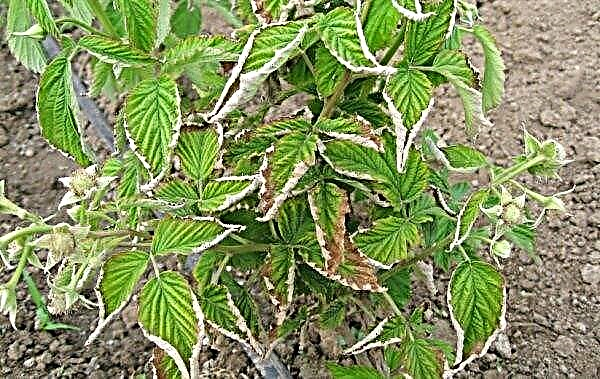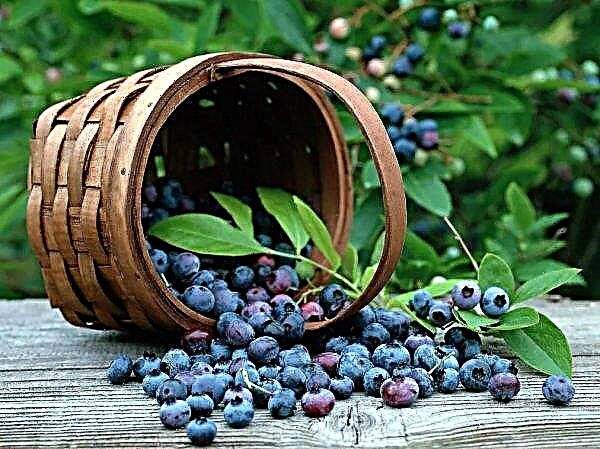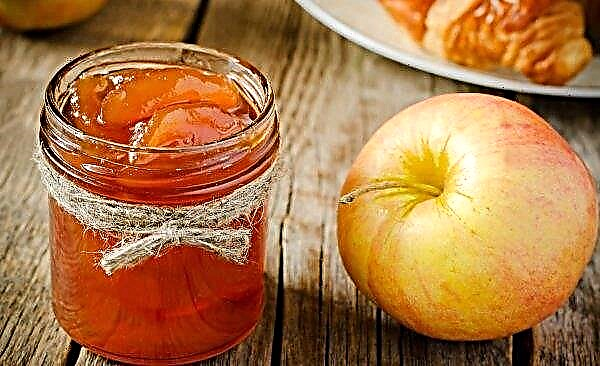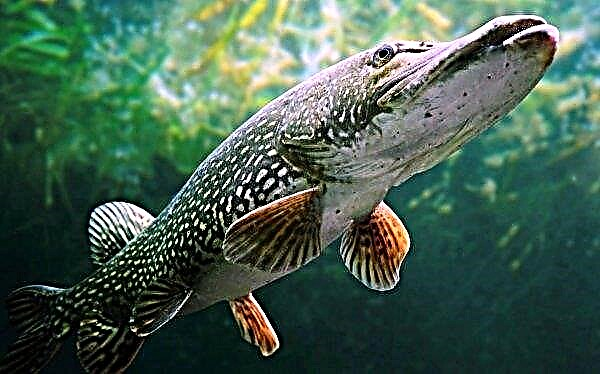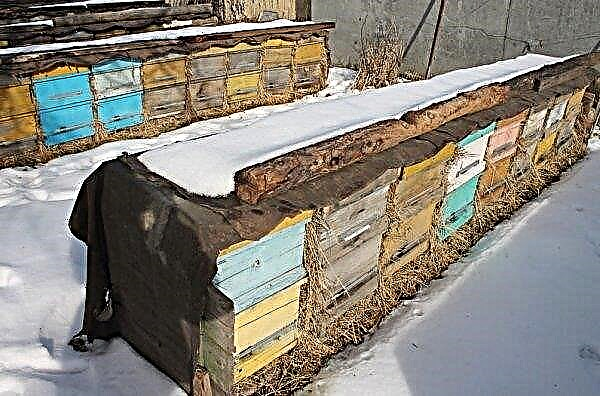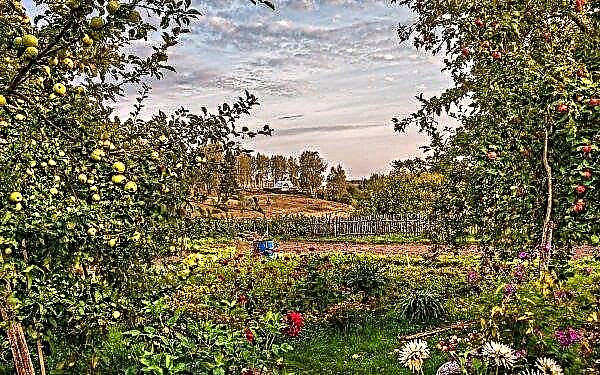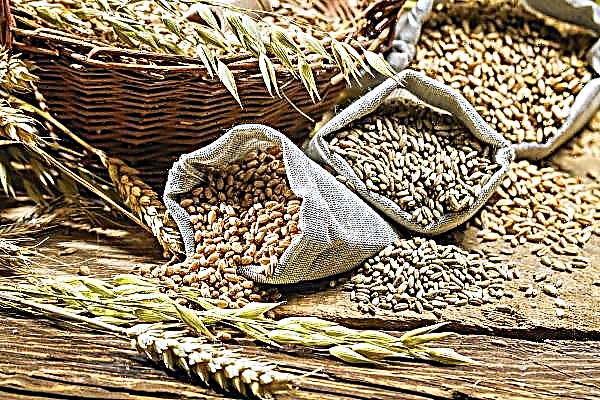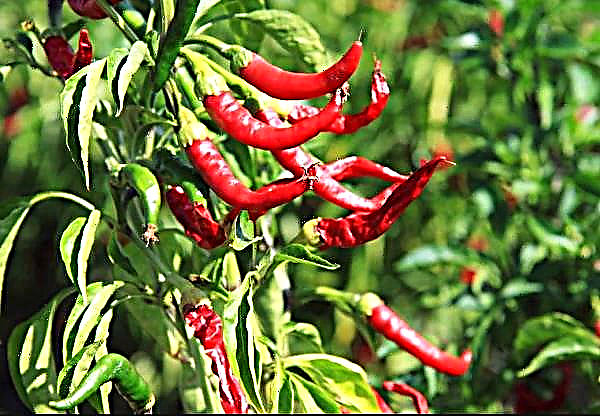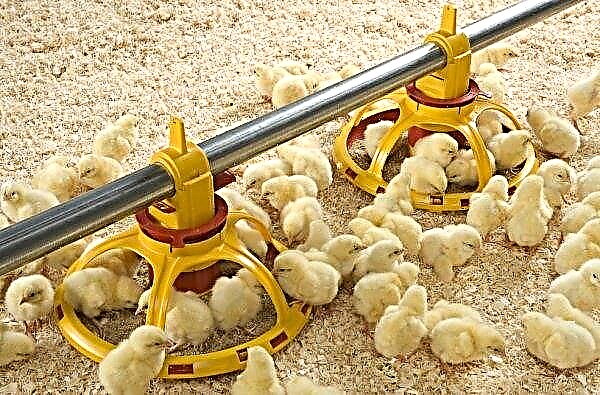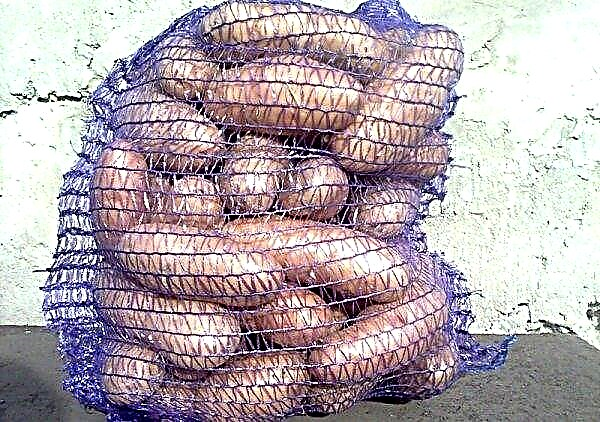Carrot root vegetable is one of the most commonly used vegetables, so it is grown on many large and small land plots. One of the best varieties giving large and tasty carrots is the Red Giant. It grows on the site all summer, and the harvest can be used immediately or stored until spring. A detailed description of the variety, its advantages and disadvantages, the rules for sowing seeds and caring for plants are discussed further in the article.
Characterization and description of the variety
Carrot Red giant (second name Rothe Riesen) was bred in Germany. The breeders of the German company Mather Zamen worked on the creation of a new type of vegetable, but it can also be grown on the territory of Moldova, Russia and Ukraine. A feature of the variety is the large size of the fruit, thanks to which this variety of carrots got its name.
Did you know? Initially, carrots were colored purple. Orange varieties of vegetables appeared only in the 17th century in the Netherlands.
Bush description
In appearance, the bush carrots Red giant practically does not differ from other varieties of vegetables. But the plants themselves are quite large, so they require a sufficient amount of free space on the bed.
The main characteristics of the plant are listed below:
- This variety belongs to late ripening - the first fruits are harvested only 140-160 days after planting seeds.
- The tops of carrots are tall and lush. It consists of long leaves of a bright dark green color, collected in a spreading rosette.
- Leaves are located on long petioles. At the same time, tall and dense tops do not always indicate large and sweet fruits.
- The edges of the leaf plate of the plant are medium-dissected, and its surface is rather rough.
- At the time of ripening, some leaves in the tops may dry out and turn yellow.
Check out these late varieties of carrots:
Description of the fetus
Carrot variety The red giant quickly gained popularity among gardeners due to the excellent commercial quality of ripe fruits. Vegetables perfectly retain their attractive appearance even after transportation and storage, have a great taste and contain many useful elements.
Root crops of the Red Giant variety have the following characteristics:
- Vegetables are elongated, have a conical shape and a blunt tip.
- The total length of ripe carrots is 22-24 cm, and the diameter is up to 6 cm.
- The average weight of the fetus is from 90 to 150 g.
- Outside, carrots are covered with a moderately dense and smooth orange peel with light ribbing. The core of the vegetable is medium or large.
- The flesh is bright orange or red. It is juicy and very sweet, because it contains up to 8.8% sugar.
- 100 g of ripe fruit contains about 16% dry matter and about 12 mg of carotene.
 Due to the attractive appearance, the harvested carrots Red Giant can be eaten raw, as well as make juice from fruits or use them in cooking to prepare various dishes.
Due to the attractive appearance, the harvested carrots Red Giant can be eaten raw, as well as make juice from fruits or use them in cooking to prepare various dishes.Productivity
One of the main advantages of the variety is its high productivity. Subject to all the rules for planting seeds and caring for plants, on average about 2–4 kg of ripe vegetables can be obtained from 1 m².
Important! The yield of commercial products for this variety is 80–87%.
Disease immunity
Carrot The red giant has good immunity, therefore it is rarely affected by diseases and pests. But in case of violation of the conditions for growing this culture or improper care, plants can become weak and susceptible to infection.
Because of this, it is recommended to create favorable conditions on carrot beds, adhere to the indicated rules for planting seeds and caring for plants, as well as regularly inspect plantings in order to notice the occurrence of problems in time.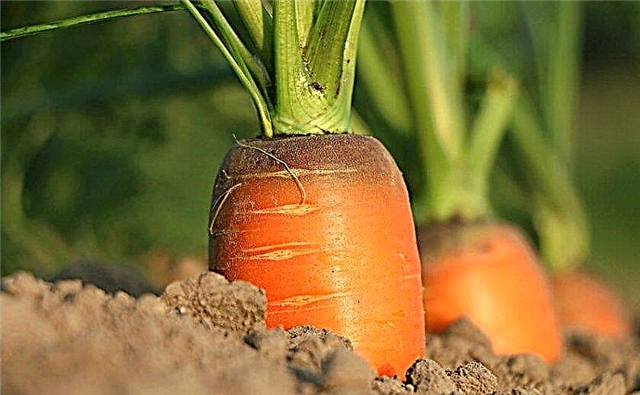
Advantages and disadvantages
This variety has gained popularity among many gardeners due to its many positive qualities. They distinguish carrots Red Giant from other varieties, so these plants are grown not only for personal needs, but also for sale through retail chains and on an industrial scale for further processing.
- The main advantages of red giant carrots include:
- high productivity;
- great taste of vegetables;
- beautiful presentation of fruits;
- good storage and transportability;
- useful chemical composition of root crops;
- persistent immunity;
- universality of the use of vegetables;
- resistance to cold;
- unpretentiousness in leaving.
Carrot Red giant has several disadvantages, but they are fully offset by the positive qualities of the variety.
- The main disadvantages of this culture are:
- long ripening fruit;
- the size of carrots may not correspond to the word "giant";
- seeds do not have 100% germination.
Cultivating varieties
In order to successfully grow Red Giant carrots in your area, you need to find a suitable place for it and correctly perform the procedure for sowing seeds. Planting should be carried out at the recommended time, taking into account weather conditions and climate characteristics of a particular growing region. Before sowing, the seeds must be properly prepared, and during their planting in the soil - adhere to the recommended planting pattern.
Did you know? Carrots were known in ancient Greece for 2000 years BC. e., and images of this vegetable are on the walls of the tombs of Egyptian pharaohs.
Dates and place for sowing
Carrot Red giant is intended for cultivation in open ground, so you can plant seeds in the soil only after it is warmed up to at least + 10 ° C. Depending on the climate conditions of each particular region, sowing is carried out in late April or in early May. Due to the cold resistance of the variety, it is also possible to carry out winter planting of seeds in late October or early November. At the same time, at the time of planting material incorporation into the soil, the air temperature should be about + 5 ° С. In winter, the beds are covered with a layer of spruce branches, sawdust or dry straw.
Due to the cold resistance of the variety, it is also possible to carry out winter planting of seeds in late October or early November. At the same time, at the time of planting material incorporation into the soil, the air temperature should be about + 5 ° С. In winter, the beds are covered with a layer of spruce branches, sawdust or dry straw.
The site for planting carrots of this variety must meet the following requirements:
- good sun exposure - in the shade, plants grow much more slowly, and the fruits are not large enough and less tasty;
- loamy or sandy loamy soil - loose and light soil is well warmed up by the sun, passes water and air to the roots;
- suitable predecessors - this crop gives a good harvest when planting in the area where potatoes, cucumbers, legumes, tomatoes and cabbage were previously grown;
- the absence of groundwater close to the surface of the soil - in the flooded areas, carrots will rot and deform.
Bad predecessors for carrots of this variety are crops such as beets, dill, parsley and celery.
Seed preparation
Before planting in the soil, the seeds of the carrots of the Red Giant need some preparation. Manufacturers recommend planting them in open ground without additional germination, but during spring planting, experienced gardeners advise nevertheless to carry out this procedure to improve the germination of planting material.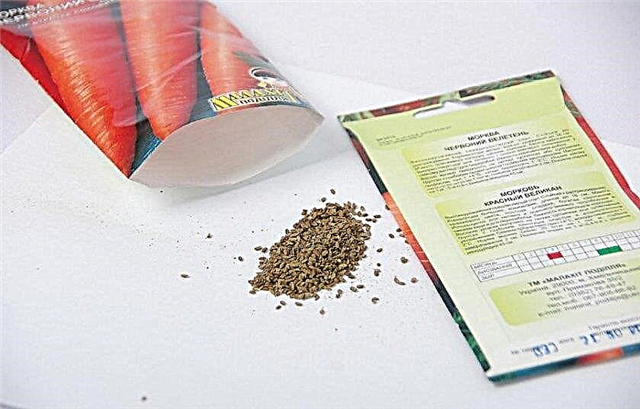
To prepare seeds for sowing in an open area, you need to take the following actions:
- place the planting material in a glass of water for several hours - high-quality seeds will settle to the bottom of the tank, and defective seeds will float to the surface;
- to disinfect, place planting material in a weak solution of potassium permanganate for several hours, and then rinse it with water and slightly dry at room temperature;
- to germinate seeds 5–7 days before planting in the soil, they need to be spread on a saucer between layers of wet gauze, and then the container should be removed in a cool place until planting;
- instead of germinating before planting, you can soak the seeds in warm water with the addition of a growth stimulant - while the planting material swells and will sprout faster after being planted in the ground.
 Prepared seed provides more powerful, healthy shoots that are resistant to adverse conditions.
Prepared seed provides more powerful, healthy shoots that are resistant to adverse conditions.Landing pattern
This variety of carrots is distinguished by the large size of the ground part, so when planting it, you must adhere to the plant layout recommended by the manufacturer. This will prevent excessive thickening in the beds and provide root crops with enough free space for successful growth.
Important! During autumn planting, the seeds of carrots of the Red Giant are planted in furrows to a depth of 3 cm, and the distance between the rows is 20-30 cm.
Step-by-step instructions for planting Red Giant carrot seeds in the soil:
- On the surface of the soil it is necessary to prepare long furrows with a depth of 1-2 cm. The distance between them should be about 20 cm.
- If the earth is very dry, then pour a small amount of warm water into each depression.
- After completely absorbing moisture, put seeds on the bottom of the furrow. You can pre-stick them on adhesive tape and then put it in the recess. The distance between adjacent seeds should be at least 4 cm.
- Gently sprinkle planting material with loose soil. The surface of the beds can be slightly sprinkled with water, but not watered, that is, seeds can be washed out of the ground.
- To create an optimal microclimate, cover the garden bed with a film until green shoots appear. Between the cover layer and the soil, it is recommended to leave about 5 cm for the shoots.
- Seeds embedded in the soil sprout 2-3 weeks after planting. After this, the film from the beds needs to be removed.

Care Features
Carrot The red giant is unpretentious in leaving, but for active growth and the formation of large root crops, plants need watering and top dressing. In the first weeks of growth, it is also important to regularly weed the beds and loosen the soil between the rowsto saturate the soil with oxygen and prevent weeds from obscuring plants. It is equally important to carry out preventive actions in time to protect against possible diseases and pests in order to preserve the crop in full.
Watering and fertilizer
During growth, plants need moisture and nutrients. Carrots Red giant responds well to moderate watering and top dressing, while the yield of the variety increases. But at the same time, it is necessary to observe a measure so as not to over-fill the beds with water and provide the sprouts with precisely those fertilizers that they most need at a particular growth stage.
Important! With insufficient watering, the carrot Red giant becomes sluggish and bitter, and excess moisture in the soil leads to cracking of vegetables.
The basic rules for watering a crop are:
- irrigation frequency - 1 time in 5-7 days, and the rate of water consumption - about 15 liters per 1 m²;
- during a severe drought, carrot beds are irrigated daily;
- if necessary, young sprouts can be watered every 3-4 days using small portions of water;
- at the stage of fruit formation and ripening, the beds are watered more abundantly, but with a large interval - 1 time in 8-10 days;
- as a result of watering, the soil around the plants should get wet to a depth of 10–20 cm;
- for irrigation of plantings, it is recommended to use the drip method using settled water, previously heated in the sun;
- to avoid rapid evaporation of moisture, watering is best done in the morning and evening hours.

Fertilizing carrot beds should be carried out according to the following rules:
- fertilizers are applied for the first time during the preparation of the site for sowing carrot seeds - in the autumn, the soil is dug up with the addition of 0.5 buckets of humus or compost, 1 bucket of peat and mineral fertilizers per unit of area;
- 15–20 days after seed germination, the plants are fed with mineral fertilizers and nitrogen-phosphorus preparations - 15 g of double superphosphate and urea and 20 g of potassium nitrate are added per 1 m²;
- at the stage of fruit formation, top dressing is made from potassium sulfate and superphosphate (15 g per 1 m²);
- the last time the beds are fertilized 30 days before the root crops are fully ripe - at the same time, 2 cups of wood ash are applied per 1 m²;
- the listed ingredients are recommended to be made in the form of a liquid mixture, dissolving them in water for irrigation;
- before feeding, the plants are watered with a small amount of clean water.
Pest and Disease Control
Carrots The red giant is rarely affected by diseases and pests, but only with the right care. If the wrong place was chosen for the cultivation of this crop or the gardener does not comply with the recommended arrangement of bushes and the watering schedule, then the immunity of the bush is reduced and it becomes susceptible to infections.
Did you know? Very large carrots were grown in 1998 in Alaska (USA). The weight of the fetus was 8.5 kg.
List of possible diseases and pests of carrots Red giant:
- Alternariosis (black rot). The causative agent of infection can be found in the upper layers of the soil, as well as on affected plants. A sign of this disease is dark brown spots on the leaves of the bush. The surface of the affected areas is covered with dark plaque of olive color, and with the further spread of fungal spores fall on the fruits, causing them to rot. Treatment is carried out with the help of fungicides (for example, "Falcon"), but first all diseased bushes are removed from the site. For prevention, before sowing seeds, the land on the site is treated with a 1% solution of Bordeaux fluid.
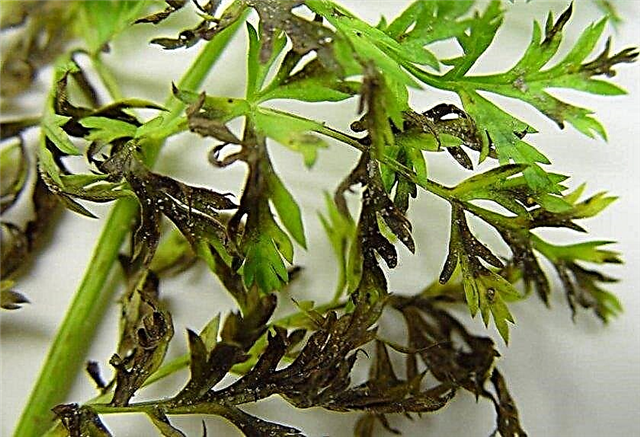
- Fomoz (dry rot). The disease has a fungal nature and first affects the tops of the plant. In this case, the leaves turn red and become covered with brown spots, and then die. Further, the infection passes to the root crop, covering it with gray spots and causing decay. The disease is not treatable, and the affected bushes urgently need to be removed and destroyed. To prevent the occurrence of infection, it is recommended to fertilize plantings with preparations containing potassium in a timely manner and spray the plants with a 1% solution of Bordeaux fluid.
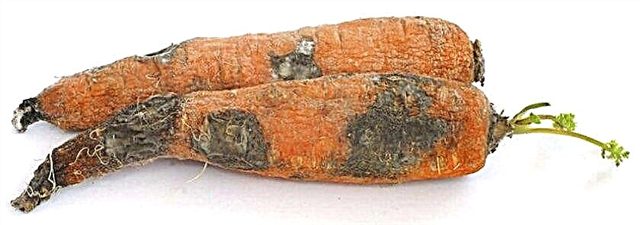
- Carrot fly. The insect lays eggs on carrot leaves, from which larvae appear. They damage the tops of the plant, which becomes yellow as a result of the lesion, and individual leaves dry out and curl up into a tube. A small amount of pests can be destroyed by sprinkling plant leaves with a mixture of tobacco and ash. With a large spread of insects, special preparations are used (for example, Intavir). To prevent the appearance of a carrot fly, you must follow the recommended rules for the care of beds and the scheme of sowing seeds.
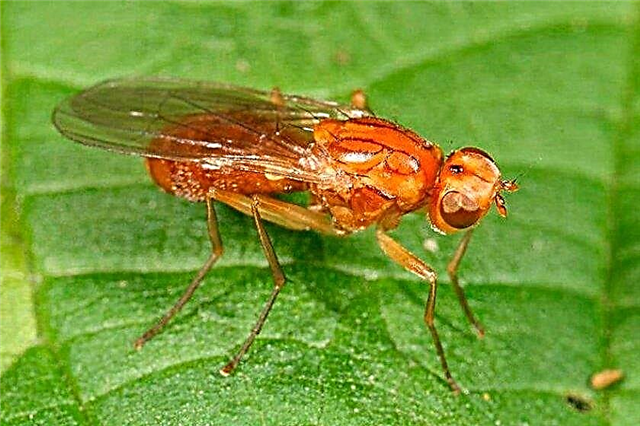
- Wireworm. The pest is a small yellow-brown caterpillar, which is the larva of the nutcracker. The wire gnaws through passages in the pulp of root crops, making them unsuitable for storage. Signs of the appearance of this pest are a slowdown in plant growth, withering tops and round holes on the surface of the vegetable, leading to its core. You can get rid of larvae with the help of preparations containing ammonia, as well as insecticides. For prevention, it is recommended to carry out a deep autumn digging of the soil with the addition of lime.
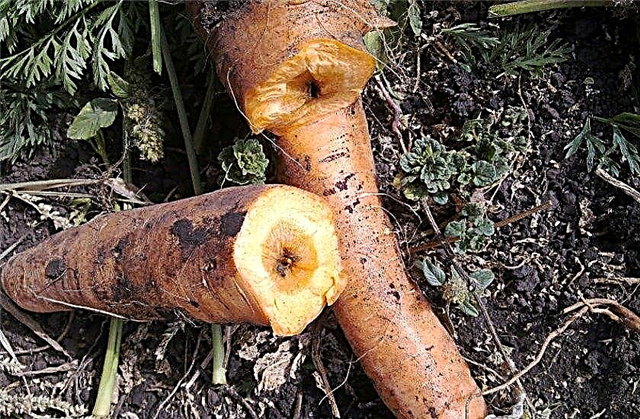 Carrots affected by wireworm.
Carrots affected by wireworm. - Medvedka. This pest lives in the upper soil layer and gnaws root crops, feeding on their juicy pulp. Signs of the appearance of a bear on carrot beds are through passages in the soil, withering of the ground part of plants and damage to root crops.With a small number of insects, they are manually selected from the ground. For effective pest control, use aqueous solutions of hot pepper and kerosene, watering them near the bushes. Such tillage can also be carried out for preventive purposes.

Thinning and weed control
To increase yield and improve the quality of fruits, it is important to ensure that the spreading plants of the Red Giant variety have enough free space. For this purpose, mandatory thinning of the plants is carried out, removing the extra sprouts.
This procedure is carried out in 2 stages:
This arrangement will stimulate the formation of large root crops of the correct form with a flat surface.When growing the Red Giant variety, it is necessary to properly care for the soil around the plants:
- regularly loosen the earth in the row-spacings to facilitate the access of air and water to the roots of the sprouts, as well as to avoid curvature of the fruit;
- periodically remove weeds growing around carrots - they draw moisture and fertilizers from the soil, and can also obscure young shoots from sunlight;
- weeding and loosening the soil - it is recommended to carry them out after rain or watering, to prevent the formation of a dense crust on the soil surface;
- at the stage of ripening vegetables, spud their tops with earth to protect them from greening as a result of subsidence of soil in the beds.
Did you know? Despite the tangible strength, the root crop is 90% water - if you kill the ripe carrots in a blender, you will get a liquid mass.
Harvesting
The harvesting time for ripe vegetables of this variety depends on the time of sowing the seeds, climate conditions and the location of the site. If the place for carrot beds was chosen taking into account the above requirements, then the root crops ripen faster.
Rules for the collection and storage of ripe vegetables:
- root crops should be harvested in clear and dry weather;
- carrots are carefully dug up with a pitchfork, and then pulled out of the ground for green tops;
- the leaves of the plant are completely cut with a sharp knife along with a small part of the top of the fruit - this will avoid the wilting of the vegetable and its decay as a result of drying of the tops;
- dug vegetables are dried in a cool place with good air circulation for several hours, and then placed in a basement or storage;
- Only whole medium-sized root crops with a smooth surface, without rot and mechanical damage are suitable for storage;
- carrots are stored in a dark place at an air temperature of about 0 ° C and a humidity of 90–95%;
- in a storage or basement with suitable microclimate conditions, carrots can be stored for 6-7 months.
Important! During the spring planting of the Red Giant variety, carrots ripen from late August to early September, and during winter sowing, in mid-July.
Independently grow carrots Red giant can even a beginner gardener. This variety is quite unpretentious in care, and if you follow all the recommendations listed above, you can get a generous harvest of ripe vegetables with excellent presentation and rich sweet taste.




 Carrots affected by wireworm.
Carrots affected by wireworm.
